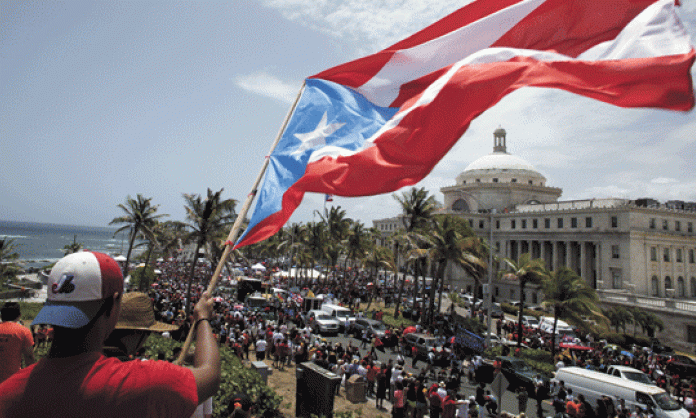The world has been focused on the spectacle of the “troika” of the IMF, the European Commission and the European Central Bank crushing the Greek people. But there are other cases of strong imperialist countries using a “debt crisis” to extract wealth from weaker ones, and also from the poorer non-imperialist countries.
A case in point is the US colony of Puerto Rico. In a New York Times interview, the governor of the Caribbean nation declared that its debt of $73 billion “is not payable”. Puerto Rico missed a 1 July deadline on an instalment of more than $1 billion.
Most of the debt is owed to US hedge funds, mutual funds or other investment accounts. The hedge funds, also known as “vulture funds”, buy debt owed by the Puerto Rican government and public enterprises at very low prices (because investors know they are almost worthless). They then demand repayment at full face value.
On 30 June, Puerto Rican officials began negotiations with creditors. Among those attending were former International Monetary Fund official Anne Kruger. Her proposed solution includes: Puerto Rico cutting the minimum wage below the federal level of $7.50 an hour, and slashing subsidies for the University of Puerto Rico.
Protesters gathered outside the Manhattan offices of the financial giant Citigroup, where the meeting took place. One protester interviewed on Democracy Now! said, “I live here in New York. I’m puertorriqueño and my parents and my family live in Puerto Rico … We are saying with one clear voice, ‘no’ to the austerity plans being proposed by Anne Krueger.
“And we are saying ‘no’ to the austerity plans being pushed by the hedge fund owners and the managers and the banksters that created similar situations in Greece, in Spain and even in this country.”
The White House has announced that the federal government will not contribute any money to help. Janet Yellen, head of the Federal Reserve Bank, said that it also will do nothing because she sees “no risk” that a default by Puerto Rico will spread to the mainland, so it’s of no concern.
This is the Federal Reserve that pumped billions into financial institutions such as Citicorp, and then lent them trillions more, in the wake of the 2008 financial collapse. So we have our own “troika” – the federal government, the Federal Reserve and the financial institutions – telling Puerto Rico to “drop dead”.
The squeeze on Puerto Rico by US finance capital comes in the context of a depression in the island group that dates back to 2005.
The poverty level is nearly double that of the poorest US state. The unemployment rate is twice that of the US. Puerto Rico’s health system is on the verge of collapse. Sixty percent of the population rely on federal programs of Medicare, Medicare Advantage or Medicaid.
Under Obamacare, Puerto Rico gets only 60 percent of the funding that states get for Medicare, and 70 percent of Medicaid funding. The shortfall amounts to a half a billion dollars that the cash-strapped country cannot afford to pay for the medical needs of its people.
Puerto Rico is excluded from the Supplemental Security Income program that aids the most vulnerable US citizens. It does not participate in the federal nutrition program. All these and other discrepancies exist because the country is a colony of the US, euphemistically labelled a “territory”.
Puerto Rico was originally a colony of Spain. It was captured by the US in the Spanish-American War of 1898, along with Cuba and the Philippines. This led to the Philippine-US War in which the US killed an estimated 200,000 Filipinos. The Philippines gained nominal independence after the Second World War. Cuba was a virtual US colony until the Cuban Revolution of 1959. But Puerto Rico remained a colony.
In the 117 years since, US companies have taken huge profits from Puerto Rico. For the first 50 years, the US sugar barons benefited from the very low plantation wages.
In the next 50 years, the US government gave US firms big tax write-offs to locate in Puerto Rico. At first, shoe and clothing manufacturers profited. More capital-intensive businesses like pharmaceuticals later moved in. That made Puerto Rico one of the top prescription drug manufacturers in the world. At one point, 13 of the top 20 prescription drugs were made in the country.
In 1996, Congress began to phase out the tax breaks, and with them much of the country’s industry. The tax breaks were fully gone by 2005. Since then, Puerto Rico has been in recession (made worse by the 2008 financial collapse and Great Recession), and forced to rely on loans to keep afloat. Consequently, in the past decade it mainly has been financial vultures sucking the country dry.
Puerto Ricans are US citizens, and are allowed to come to the mainland. They can’t be kept out like Mexicans fleeing poverty, who are forced to enter the US without documents. About 50,000 Puerto Ricans currently do so every year. There are 5 million puertorriqueños living on the mainland, and 3.5 million in the colony.
Puerto Rico simply has no more money to pay the loan sharks. To top it off, because it is a colony, it isn’t allowed to declare bankruptcy like a state or a city such as Detroit. And like Greece, it doesn’t have its own currency.
It’s not clear what the outcome will be. Will it, like Greece, be forced to take out even more loans with interest to pay previous loans and accumulated interest while implementing even more austerity?










